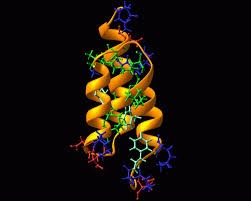
Holla hommes! Welcome back! On this post we’re talking about Nucleotides and Nucleic Acids…which should be hella obvious from the title, or not, but what-evz! Now you know. So what is a nucleotide? Well that’s pretty simple. A nucleotide is an organic molecule that is a subunit of the nucleic acids DNA and RNA. What are they made up of you may ask? And to this question I shall answer that it is a nucleoside + a phosphate. And now you want to know what a nucleoside is made up of right? Of course you do. A nucleoside made up of a nitrogenous base + five-carbon sugar therefore a nucleotide is a nitrogenous base + five-carbon sugar + phosphate.

Okay, so how about we get all up in this nucleotide and see what’s going on with the sugar! By the way, the sugar is the main characteristic of the DNA and RNA. Deoxyribonucleic acid who goes by the street name DNA is made up of deoxyribose and Ribonucleic acid whose street name is RNA (as you may have guessed) is made up of ribose sugar. (The ‘de’ in deoxyribose indicates the lack of oxygen on the second carbon in the ribose sugar.)
Our homme DNA

DNA – The mysterious double helix, self-replicating material that makes up our chromosomes and is the carrier for our genetic information. As mentioned before DNA is made up of a five-carbon sugar, a nitrogenous base, and a phosphate. Lets talk about the nitrogenous bases in DNA. There are two categories of nitrogenous bases, single ring and double ring. The single ring bases are known as pyrimidines, which consist of Cytosine (C), Thymine (T) and Uracil (in RNA) and double ring bases are purine, which consist of Adenine (A) and Guanine (G). In DNA a purine always pairs with a pyrimidine by means of a hydrogen bond, which is strong enough to hold them together, but also allows them to be separated when necessary. This bonding creates the ladder seen in the double helix formation. Adenine is paired with Thymine and Cytosine is paired with Guanine. The backbone, which is seen on the outskirts of the double helix, is made of sugar-phosphate pairs. The backbones run from 3’ (3 prime) – the sugar end to 5’ (5 prime) – the phosphate end and are anti-parallel to each other. Therefore one side is 3’ – 5’ and the other side is 5’ to 3’.
Namingggg! (The simplest part)
For Nucleosides:
– For purine nucleosides would simply change the ending to “-sine”: Guanosine & Adenosine
– For pyrimidine nucleosides you would change the ending to “-dine”: Thymidine, Uridine, Cytidine,
For Nucleotides:
– You would begin with the nucleoside name above and then add “mono-”, “di-”, or “triphosphate” according to the number of phosphates present (Mono=1, Di=2, Tri=3): Adenosine Monophosphate, Cytidine Triphosphate, Deoxythymidine Diphosphate.
I know you’re like, seriously though, like what’s the big deal with nucleotides?

Welllllll I’ll tell you what the big deal is! First of all, nucleotides are the building blocks of DNA and RNA. Meaning with out them we’d be nothing, zip, zilch, zero, and nada homie! They can be compared to amino acids in their role in proteins. They are responsible for selectively binding to a protein and regulating its activities. In other words they are allosteric effectors. They serve as an energy currency in cellular metabolism and they make up the structures of many enzyme cofactors?
And now you’re all like, what about nucleic acids!!?
Gosh chill, I was getting there. Well most importantly, DNA has the information needed to create fuctional proteins and RNAs. They also have promoters that assist in the regulation of gene expression. rRNAs or Ribosomal RNAs help to make up ribosomes and they help with the creation of proteins. mRNAs (Messenger RNAs) are like FedEx for genetic information. They transport genetic information from the gene to the ribosome. tRNAs decode information in mRNAs into an amino acid sequence and some RNAs can increase the rate of biochemical reactions
Most Famous Nucleotide!! – ATP!!!

Real name, Adenosine Triphosphate isanucleotide containing adenine, ribose, and a triphosphate group.ATP is often wrongly referred to as an energy-storage molecule, however a more accurate term would be an energy carrier or energy transfer agent. ATP diffuses though the cell to make energy so that the cell can perform other work such as ion transport, cell movement and biosynthetic reaction. ATP’s chemical potential energy is made available when one or two of its phosphate groups are relocated to another molecule. This course of action can be denoted by the hydrolysis of ATP to ADP.
Forms of Nucleic Acids
B form – This is the most common conformation for DNA.
A form – This is common for RNA and is favored in conditions of low water. Contains deeper minor groove and shallow major groove.
Z form – Contains narrow, deep minor groove and the major groove is hardly existent. This can form for some DNA sequences and requires alternating syn and anti base configurations. It is known as being left handed, meaning that is coil in the left direction. Z form also contains high salt/charge neutralization.
And finally: Stability of Nucleic Acids
Nucleic acids contain hydrogen bonding but it is not usually a factor the stability of nucleic acids however it contributes to the double helix in DNA and RNA secondary structure. What does contribute to the nucleic acid stability is the hydrophobic interaction between base pairs. It is favorable for the hydrophobic bases to exclude waters and stack on top of each and this stacking is expand in double-stranded DNA.
Thanks so much for reading and I hope you found it informative and helpful.
Chao for now!
















